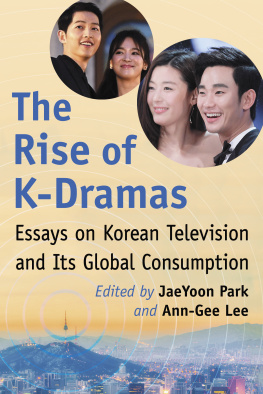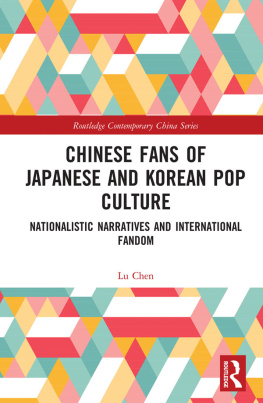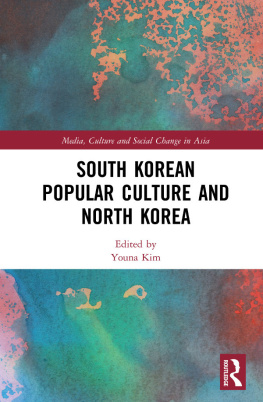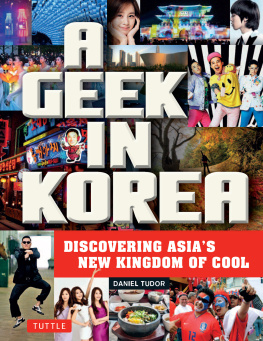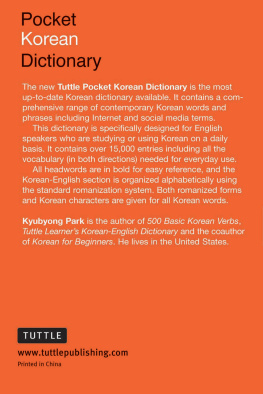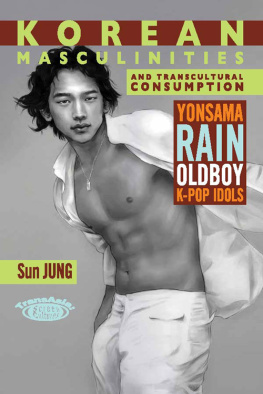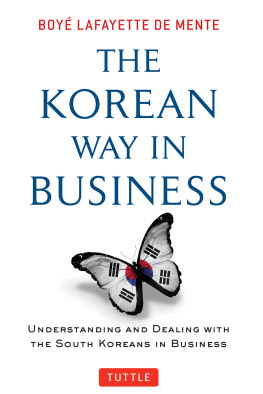The Rise of K-Dramas
The Rise of K-Dramas
Essays on Korean Television and Its Global Consumption
Edited by JaeYoon Park and Ann-Gee Lee

McFarland & Company, Inc., Publishers
Jefferson, North Carolina
Library of Congress Cataloguing-in-Publication Data
Names: Park, JaeYoon, 1973 editor. | Lee, Ann-Gee, 1977 editor.
Title: The rise of K-dramas : essays on Korean television and its global consumption / edited by JaeYoon Park and Ann-Gee Lee.
Description: Jefferson, North Carolina : McFarland & Company, Inc., Publishers, 2019 | Includes bibliographical references and index.
Identifiers: LCCN 2019017088 | ISBN 9781476677477 (paperback : acid free paper)
Subjects: LCSH: Television programsKorea (South)History and criticism. | Television plays, KoreanHistory and criticism. | Popular cultureKorea (South) | Popular culture and globalization. | Mass media and cultureKorea (South)
Classification: LCC PN1992.3.K6 R57 2019 | DDC 302.23/095195dc23
LC record available at https://lccn.loc.gov/2019017088
British Library cataloguing data are available
ISBN (print) 978-1-4766-7747-7
ISBN (ebook) 978-1-4766-3658-0
2019 JaeYoon Park and Ann-Gee Lee. All rights reserved
No part of this book may be reproduced or transmitted in any form or by any means, electronic or mechanical, including photocopying or recording, or by any information storage and retrieval system, without permission in writing from the publisher.
Front cover: (top, left to right) Song Joong-ki, Song Hye-kyo, Jun Ji-hyun and Kim Soo-hyun; bottom photograph by Atakorn Daengpanya (Shutterstock)
Printed in the United States of America
McFarland & Company, Inc., Publishers
Box 611, Jefferson, North Carolina 28640
www.mcfarlandpub.com
Preface
JaeYoon Park
Living and teaching in a small town in Arkansas, I did not expect to hear a Korean greeting, Annyeonghaseyo , during a community event. I turned around and saw a young woman who then bowed to me in a Korean style. She was not Korean; she had never visited Korea before; nonetheless, she demonstrated an excellent maneuver of the Korean language and cultural knowledge. Even though we had never met, she readily knew by my name that I was originally from Korea. Later on, I met quite a few Arkansans like her. I found out that although there are no Korean classes taught anywhere nearby, they were all self-taught through various Internet and new media resources while listening to their favorite Korean popular songs (K-pop) and watching Korean dramas (K-dramas) . They comprise just a small part of the Korean Wave (or hallyu ) fans.
I recall the time when I heard Gangnam Style on a local radio station while driving in Kansas a few years ago. I was teaching at a mid-size university and living in a college town in Kansas. The song went viral on the Internet, and it was, in fact, the first time that any piece of Korean popular culture gained recognition in mainstream U.S. media . In the late 1990s, the Korean Wave (hereafter hallyu ) began crossing national borders, primarily in East Asia first, then throughout the Asian region in general. I heard the news about hallyu reaching its influence all over the world, including Latin American countries, Europe, the Middle East, and even Africa. While living and teaching in Kansas, I occasionally met hard-core hallyu fans . Yet they were all young college students who usually became fascinated with Japanese or Asian culture first, and then somehow transferred their interest into a then-new phenomenon called hallyu . They were early adopters, somewhat isolated from one another. Even when Gangnam Style became sensationally popular throughout the globe, it was still deemed an exceptiona viral sensation, not enough to revert the larger, transnational cultural flows. South Korea remained in the periphery as a regional center, although it was an increasingly powerful and influential producer and exporter of cultural products.
Yet, it feels different. Something has shifted in recent years. The more I travel around North America, the more I can sense a change. My Koreanness is often associated with a young, new, and trendy culture. Korea is cool. Before hallyu , it was the military culture: people I met would talk about their grandfathers or fathers stories when they fought during the Korean War; or they would tell me their experiences when stationed in South Korea as American G.I.s. Now, people want to talk to me about their addiction to Korean dramas, and they also ask me where to buy Korean beauty products. I became curious.
When putting out a Call for Papers for this particular collection, I was pleasantly surprised to receive interests from authors of diverse national origins and geographical locations. The contributors of this collection are not only from the U.S. and Korea, but also from the UK, the Netherlands, Taiwan, Japan, Turkey, and Brazil. This collection of essays thus provides various perspectives on the cultural phenomenon of passionately watching and consuming Korean dramas around the globe.
I would like to thank all the contributors in this book for collaborating so patiently and pleasantly. I am grateful to Dr. Tamara Falicov, Dr. Novotny Lawrence, and Dr. Yan Bing Zhang for their valuable advice and support. I am also appreciative of Natalie Foreman, associate editor at McFarland, for her support and belief in this book. I would also like to thank Dr. Ann-Gee Lee, my coeditor for this collection. Without her, this publication would not have been possible. Kamsahamnida .
Introduction
JaeYoon Park
With the proliferation of global media on the Internet, Korean television dramas (hereafter K-dramas) have quickly become a popular phenomenon. Not just permeating Asia, but also appearing in the U.S., the Middle East, Europe, and Spanish-speaking countries among others, these dramas have led to fans scrambling to provide subtitles in their own languages. Along with being enthralled with characters and storylines, fans find themselves listening to soundtracks and following their favorite actors to other K-dramas. According to Y. Kim (2013) in the book, The Korean Wave: Korean Media Go Global , Korean TV dramas are emotionally powerful and self-reflexive. While Korean producers do not pay particular attention to a global formula for the success of TV drama, nevertheless they have found its affective form useful to touch the sensibilities of disparate audiences (p. 7) . This goes to show that anyone can find a K-drama suitable to their tastes: they can select from Korean period dramas, comedy, romance, action, horror, sci-fi, crime/thriller, and so on.
Furthermore, K-dramas provide food for thought on numerous topics of study. The increasing popularity of K-dramas across the globe draws a great deal of critical attention from media scholars, fan studies, and cultural studies scholars alike. As J. Kim (2014) observes, it is the most recent transnational television phenomenon in East Asia, one that has most lately produced the greatest commitment from the largest number of viewers and has been attributed with most profoundly affecting regional dynamics (p. 7) . Thus, this book raises the following questions: What aspects of K-dramas appeal to audiences across different cultures and national boundaries? What types of influences can this K-drama craze have over transnational, committed fans who are willing to spend their valuable time and money to consume K-dramas and hallyu -related products? What are the implications of the K-drama craze for changing regional and global dynamics?

